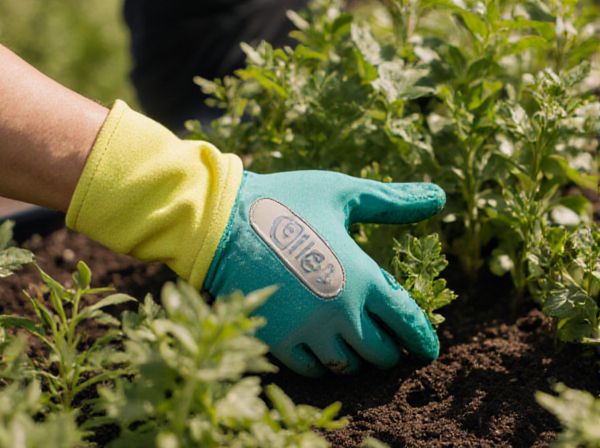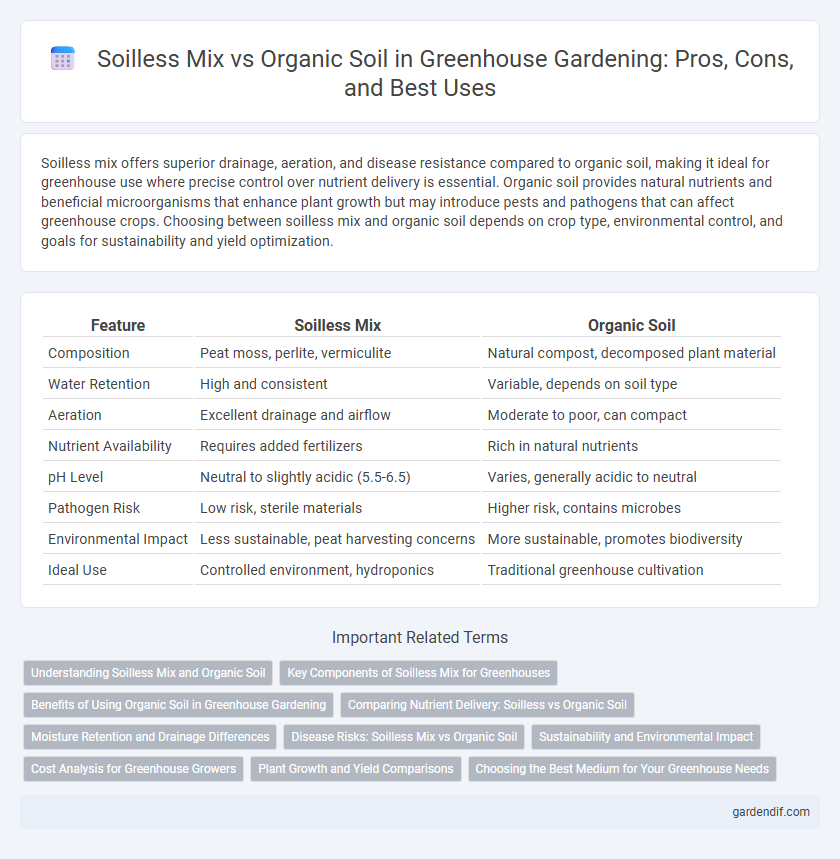
Soilless mix vs Organic soil Illustration
Soilless mix offers superior drainage, aeration, and disease resistance compared to organic soil, making it ideal for greenhouse use where precise control over nutrient delivery is essential. Organic soil provides natural nutrients and beneficial microorganisms that enhance plant growth but may introduce pests and pathogens that can affect greenhouse crops. Choosing between soilless mix and organic soil depends on crop type, environmental control, and goals for sustainability and yield optimization.
Table of Comparison
| Feature | Soilless Mix | Organic Soil |
|---|---|---|
| Composition | Peat moss, perlite, vermiculite | Natural compost, decomposed plant material |
| Water Retention | High and consistent | Variable, depends on soil type |
| Aeration | Excellent drainage and airflow | Moderate to poor, can compact |
| Nutrient Availability | Requires added fertilizers | Rich in natural nutrients |
| pH Level | Neutral to slightly acidic (5.5-6.5) | Varies, generally acidic to neutral |
| Pathogen Risk | Low risk, sterile materials | Higher risk, contains microbes |
| Environmental Impact | Less sustainable, peat harvesting concerns | More sustainable, promotes biodiversity |
| Ideal Use | Controlled environment, hydroponics | Traditional greenhouse cultivation |
Understanding Soilless Mix and Organic Soil
Soilless mix typically consists of components like peat moss, perlite, and vermiculite, providing excellent aeration and drainage for greenhouse plants while being free from pathogens and weeds. Organic soil contains decomposed plant and animal matter, rich in nutrients that support microbial activity and natural fertility, but can vary in texture and may harbor pests. Understanding the differences helps greenhouse growers select the ideal growing medium to optimize plant health, growth rate, and nutrient availability.
Key Components of Soilless Mix for Greenhouses
Soilless mixes for greenhouses primarily consist of peat moss, perlite, and vermiculite, offering superior aeration and moisture retention compared to traditional organic soil. These components provide a sterile, lightweight medium that reduces the risk of soil-borne diseases and pests, crucial for consistent plant growth. Nutrient delivery in soilless mixes is precisely controlled, enhancing root health and fostering optimal greenhouse crop yields.
Benefits of Using Organic Soil in Greenhouse Gardening
Organic soil in greenhouse gardening enriches plant growth by providing a natural balance of essential nutrients and beneficial microorganisms that enhance soil fertility and structure. This promotes healthier root development and improves water retention, reducing the need for frequent watering compared to soilless mixes. Furthermore, organic soil supports sustainable gardening practices by recycling organic matter, fostering biodiversity, and minimizing synthetic chemical inputs.
Comparing Nutrient Delivery: Soilless vs Organic Soil
Soilless mixes offer precise nutrient delivery through controlled formulations of peat, perlite, and vermiculite, enabling rapid nutrient uptake and consistent availability for greenhouse plants. Organic soil provides a complex nutrient profile derived from decomposed organic matter, promoting gradual nutrient release and enhancing microbial activity that supports long-term soil fertility. Comparing nutrient delivery, soilless mixes excel in immediate nutrient availability and pH stability, while organic soil enhances nutrient cycling and soil structure, benefiting sustainable greenhouse cultivation.
Moisture Retention and Drainage Differences
Soilless mixes, composed primarily of peat moss, perlite, and vermiculite, offer superior moisture retention and excellent drainage due to their lightweight composition and aeration properties. Organic soil, enriched with natural humus and decomposed plant material, retains water longer but may lead to slower drainage and potential root oxygen depletion. Choosing between soilless mix and organic soil depends on balancing moisture needs with drainage efficiency to optimize plant root health in a greenhouse environment.
Disease Risks: Soilless Mix vs Organic Soil
Soilless mixes significantly reduce disease risks in greenhouses due to their sterile composition, which minimizes harmful pathogens commonly found in organic soil. Organic soil often harbors fungi, bacteria, and nematodes that contribute to plant diseases like damping-off and root rot. Using soilless media improves disease management by providing a clean, inert growing environment that enhances root health and reduces the need for chemical treatments.
Sustainability and Environmental Impact
Soilless mixes, composed of peat, coconut coir, and perlite, offer enhanced water retention and aeration, reducing the need for chemical fertilizers and minimizing runoff pollution, thus promoting sustainability in greenhouse cultivation. Organic soil, rich in natural microorganisms and organic matter, supports biodiversity and carbon sequestration but may require more frequent nutrient supplementation and water, potentially increasing environmental impact. Choosing soilless media can lower greenhouse resource use and pollution, while organic soil emphasizes ecological balance and long-term soil health.
Cost Analysis for Greenhouse Growers
Soilless mixes typically offer lower initial costs and faster crop turnover times compared to organic soil, reducing overhead expenses for greenhouse growers. Although organic soil may incur higher upfront costs due to sourcing and amendments, its nutrient retention and microbial activity can decrease long-term fertilizer expenditures. Efficient cost analysis considers mix prices, crop yield, input requirements, and labor intensity to optimize profitability in greenhouse operations.
Plant Growth and Yield Comparisons
Soilless mixes, composed of inert materials like peat, perlite, and vermiculite, provide superior aeration and drainage, promoting faster root development and increased nutrient uptake compared to organic soil. Organic soil, rich in natural microbial activity and organic matter, enhances long-term soil fertility but may slow initial plant growth due to variable nutrient availability. Studies indicate soilless mixes can result in higher yields and more consistent crop quality in controlled greenhouse environments, while organic soils support sustainable growth with gradual nutrient release.
Choosing the Best Medium for Your Greenhouse Needs
Soilless mixes, composed of peat moss, perlite, and vermiculite, offer excellent drainage and aeration, making them ideal for controlled greenhouse environments where disease prevention and root health are priorities. Organic soil, rich in natural nutrients and beneficial microorganisms, supports sustainable growth and enhances plant resilience, but requires careful management to avoid pests and nutrient imbalances. Selecting the best medium depends on crop type, maintenance capabilities, and environmental conditions within the greenhouse to maximize yield and plant health.
Soilless mix vs Organic soil Infographic

 gardendif.com
gardendif.com